Welfare System Analysis: Comparing Japanese and US Models
VerifiedAdded on 2022/08/12
|6
|1406
|49
Essay
AI Summary
This essay provides a comparative analysis of the welfare models employed by Japan and the United States. It begins by outlining the key features of Japan's welfare system, emphasizing its focus on family support, rigorous eligibility criteria, and emphasis on self-reliance. The essay then contrasts this with the US system, highlighting differences in medical care, the availability of multiple aid programs, and differing social norms, such as the prevalence of unwed mothers. The author argues that the Japanese model, with its emphasis on family ties and long-term benefits, may not be directly applicable to the US due to differences in living costs, cultural attitudes towards family support, and the prevalence of factors such as drug addiction. The essay concludes that while both countries have distinct welfare policies, the context and societal factors make a direct transfer of the Japanese model to the US unlikely.
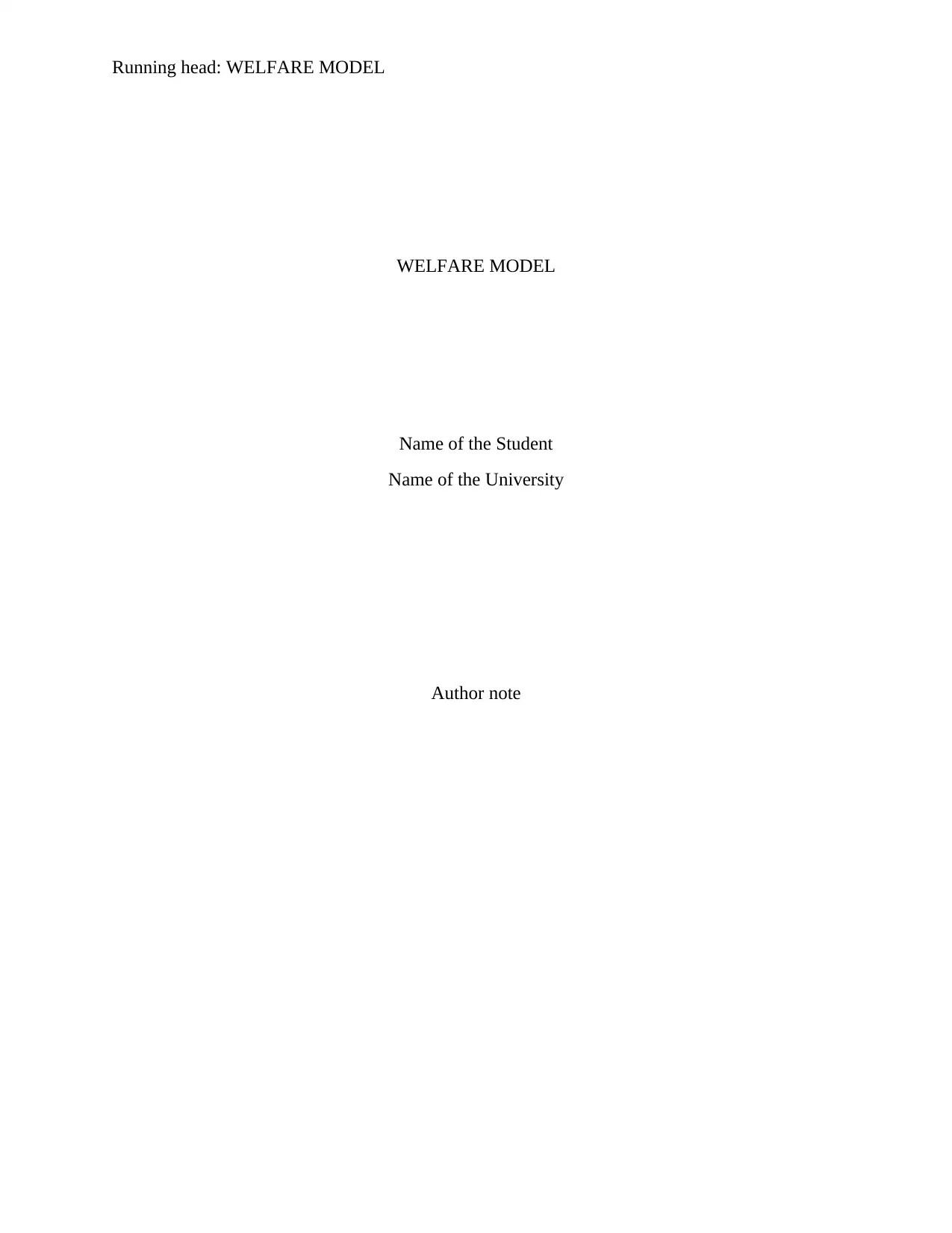
Running head: WELFARE MODEL
WELFARE MODEL
Name of the Student
Name of the University
Author note
WELFARE MODEL
Name of the Student
Name of the University
Author note
Paraphrase This Document
Need a fresh take? Get an instant paraphrase of this document with our AI Paraphraser
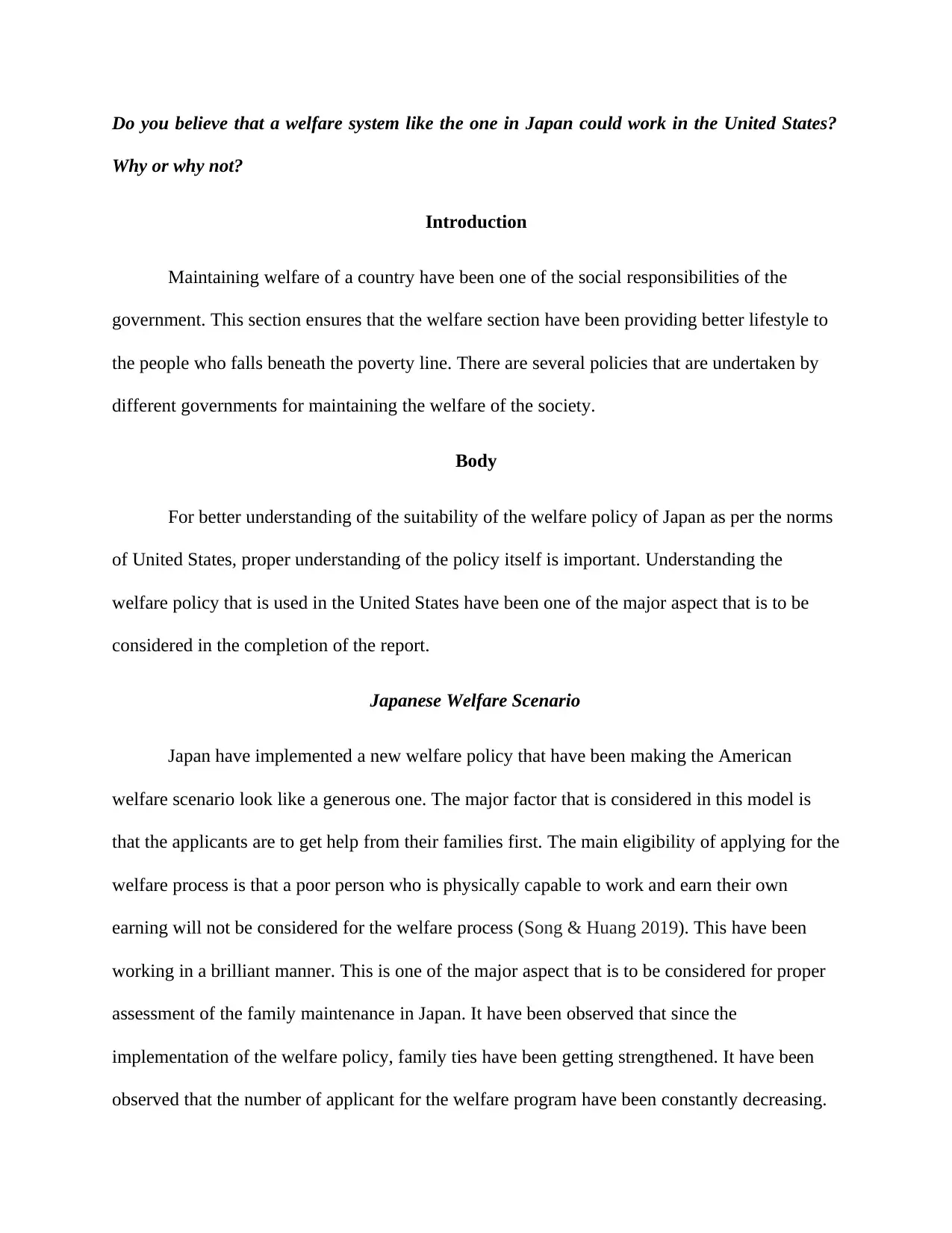
Do you believe that a welfare system like the one in Japan could work in the United States?
Why or why not?
Introduction
Maintaining welfare of a country have been one of the social responsibilities of the
government. This section ensures that the welfare section have been providing better lifestyle to
the people who falls beneath the poverty line. There are several policies that are undertaken by
different governments for maintaining the welfare of the society.
Body
For better understanding of the suitability of the welfare policy of Japan as per the norms
of United States, proper understanding of the policy itself is important. Understanding the
welfare policy that is used in the United States have been one of the major aspect that is to be
considered in the completion of the report.
Japanese Welfare Scenario
Japan have implemented a new welfare policy that have been making the American
welfare scenario look like a generous one. The major factor that is considered in this model is
that the applicants are to get help from their families first. The main eligibility of applying for the
welfare process is that a poor person who is physically capable to work and earn their own
earning will not be considered for the welfare process (Song & Huang 2019). This have been
working in a brilliant manner. This is one of the major aspect that is to be considered for proper
assessment of the family maintenance in Japan. It have been observed that since the
implementation of the welfare policy, family ties have been getting strengthened. It have been
observed that the number of applicant for the welfare program have been constantly decreasing.
Why or why not?
Introduction
Maintaining welfare of a country have been one of the social responsibilities of the
government. This section ensures that the welfare section have been providing better lifestyle to
the people who falls beneath the poverty line. There are several policies that are undertaken by
different governments for maintaining the welfare of the society.
Body
For better understanding of the suitability of the welfare policy of Japan as per the norms
of United States, proper understanding of the policy itself is important. Understanding the
welfare policy that is used in the United States have been one of the major aspect that is to be
considered in the completion of the report.
Japanese Welfare Scenario
Japan have implemented a new welfare policy that have been making the American
welfare scenario look like a generous one. The major factor that is considered in this model is
that the applicants are to get help from their families first. The main eligibility of applying for the
welfare process is that a poor person who is physically capable to work and earn their own
earning will not be considered for the welfare process (Song & Huang 2019). This have been
working in a brilliant manner. This is one of the major aspect that is to be considered for proper
assessment of the family maintenance in Japan. It have been observed that since the
implementation of the welfare policy, family ties have been getting strengthened. It have been
observed that the number of applicant for the welfare program have been constantly decreasing.
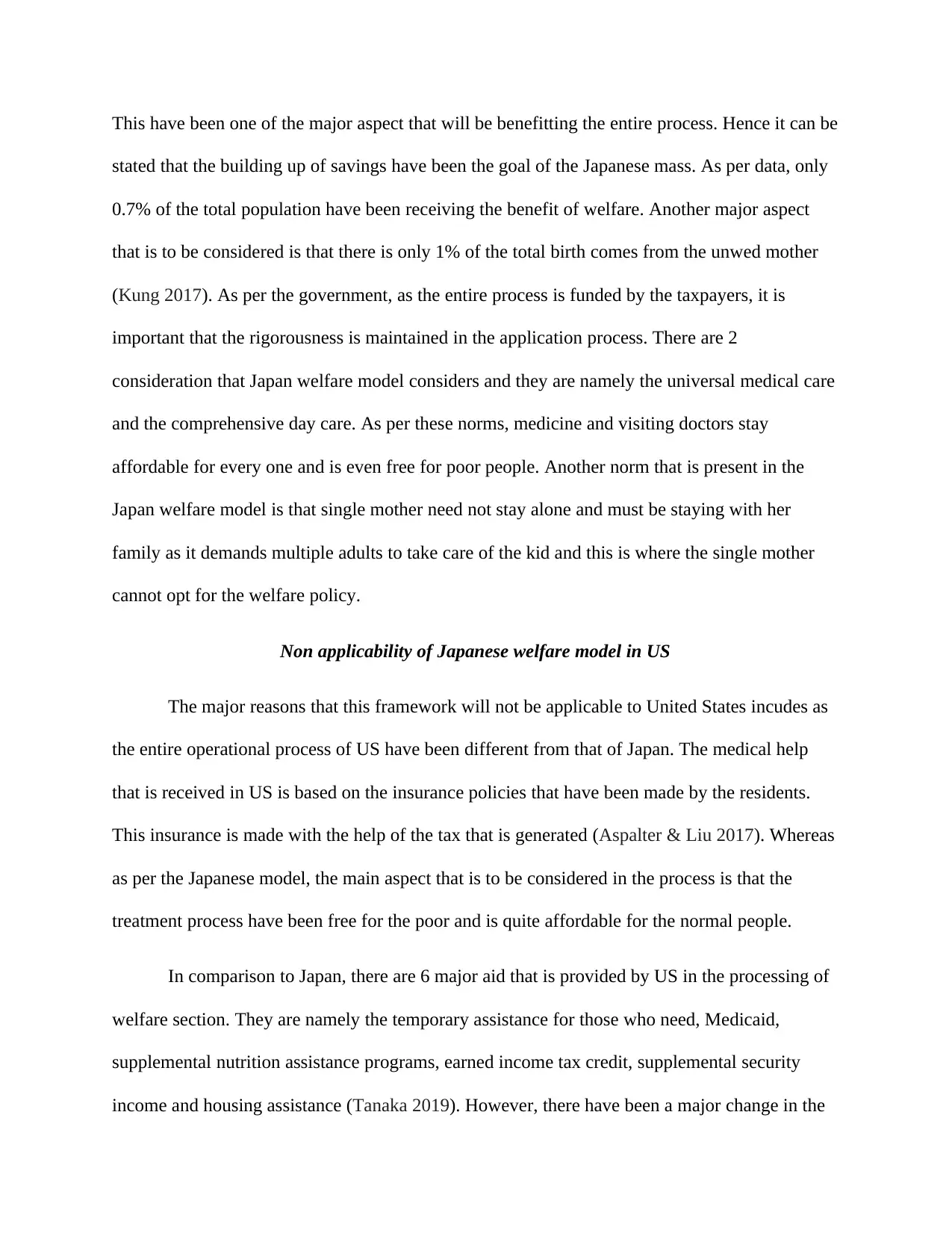
This have been one of the major aspect that will be benefitting the entire process. Hence it can be
stated that the building up of savings have been the goal of the Japanese mass. As per data, only
0.7% of the total population have been receiving the benefit of welfare. Another major aspect
that is to be considered is that there is only 1% of the total birth comes from the unwed mother
(Kung 2017). As per the government, as the entire process is funded by the taxpayers, it is
important that the rigorousness is maintained in the application process. There are 2
consideration that Japan welfare model considers and they are namely the universal medical care
and the comprehensive day care. As per these norms, medicine and visiting doctors stay
affordable for every one and is even free for poor people. Another norm that is present in the
Japan welfare model is that single mother need not stay alone and must be staying with her
family as it demands multiple adults to take care of the kid and this is where the single mother
cannot opt for the welfare policy.
Non applicability of Japanese welfare model in US
The major reasons that this framework will not be applicable to United States incudes as
the entire operational process of US have been different from that of Japan. The medical help
that is received in US is based on the insurance policies that have been made by the residents.
This insurance is made with the help of the tax that is generated (Aspalter & Liu 2017). Whereas
as per the Japanese model, the main aspect that is to be considered in the process is that the
treatment process have been free for the poor and is quite affordable for the normal people.
In comparison to Japan, there are 6 major aid that is provided by US in the processing of
welfare section. They are namely the temporary assistance for those who need, Medicaid,
supplemental nutrition assistance programs, earned income tax credit, supplemental security
income and housing assistance (Tanaka 2019). However, there have been a major change in the
stated that the building up of savings have been the goal of the Japanese mass. As per data, only
0.7% of the total population have been receiving the benefit of welfare. Another major aspect
that is to be considered is that there is only 1% of the total birth comes from the unwed mother
(Kung 2017). As per the government, as the entire process is funded by the taxpayers, it is
important that the rigorousness is maintained in the application process. There are 2
consideration that Japan welfare model considers and they are namely the universal medical care
and the comprehensive day care. As per these norms, medicine and visiting doctors stay
affordable for every one and is even free for poor people. Another norm that is present in the
Japan welfare model is that single mother need not stay alone and must be staying with her
family as it demands multiple adults to take care of the kid and this is where the single mother
cannot opt for the welfare policy.
Non applicability of Japanese welfare model in US
The major reasons that this framework will not be applicable to United States incudes as
the entire operational process of US have been different from that of Japan. The medical help
that is received in US is based on the insurance policies that have been made by the residents.
This insurance is made with the help of the tax that is generated (Aspalter & Liu 2017). Whereas
as per the Japanese model, the main aspect that is to be considered in the process is that the
treatment process have been free for the poor and is quite affordable for the normal people.
In comparison to Japan, there are 6 major aid that is provided by US in the processing of
welfare section. They are namely the temporary assistance for those who need, Medicaid,
supplemental nutrition assistance programs, earned income tax credit, supplemental security
income and housing assistance (Tanaka 2019). However, there have been a major change in the
⊘ This is a preview!⊘
Do you want full access?
Subscribe today to unlock all pages.

Trusted by 1+ million students worldwide
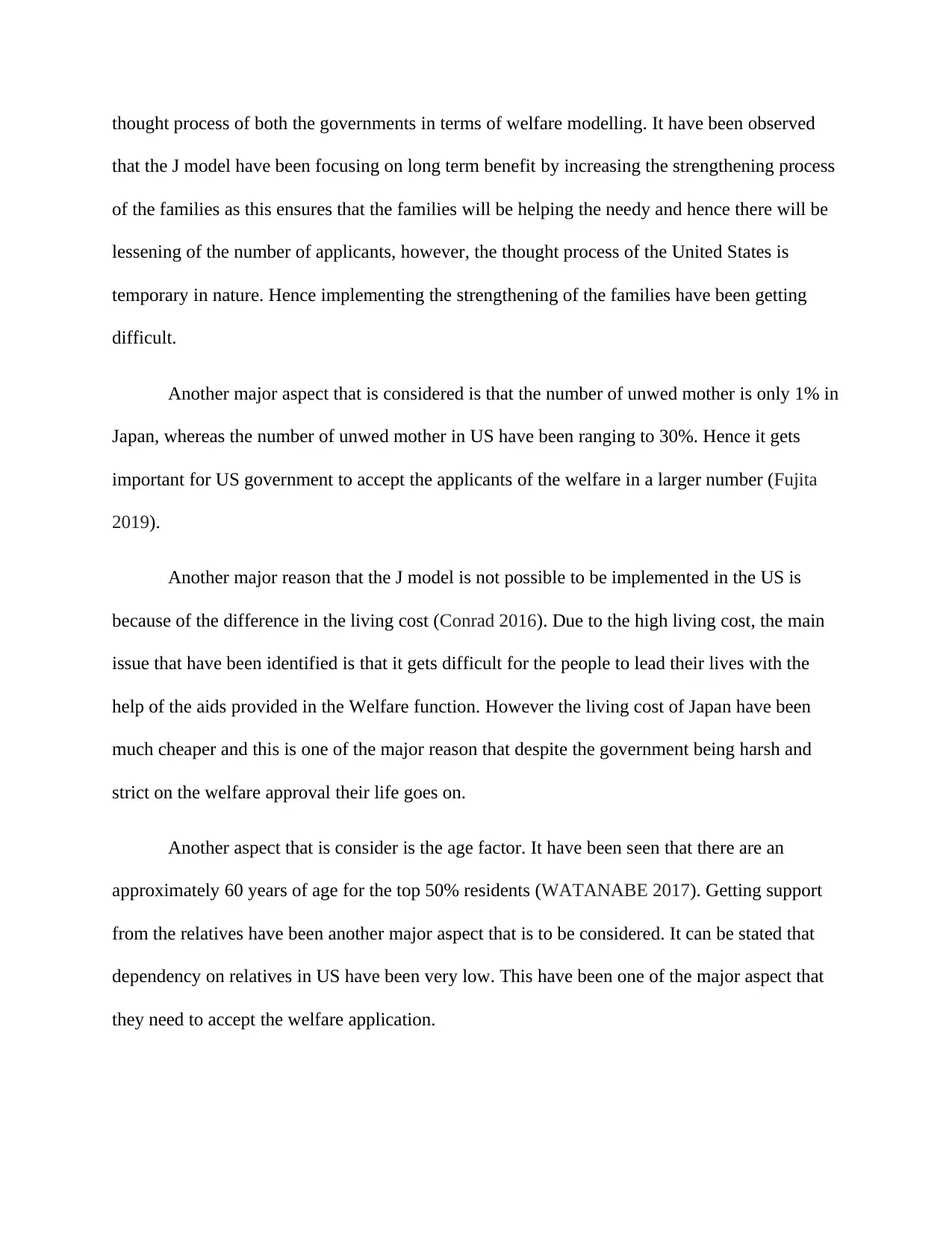
thought process of both the governments in terms of welfare modelling. It have been observed
that the J model have been focusing on long term benefit by increasing the strengthening process
of the families as this ensures that the families will be helping the needy and hence there will be
lessening of the number of applicants, however, the thought process of the United States is
temporary in nature. Hence implementing the strengthening of the families have been getting
difficult.
Another major aspect that is considered is that the number of unwed mother is only 1% in
Japan, whereas the number of unwed mother in US have been ranging to 30%. Hence it gets
important for US government to accept the applicants of the welfare in a larger number (Fujita
2019).
Another major reason that the J model is not possible to be implemented in the US is
because of the difference in the living cost (Conrad 2016). Due to the high living cost, the main
issue that have been identified is that it gets difficult for the people to lead their lives with the
help of the aids provided in the Welfare function. However the living cost of Japan have been
much cheaper and this is one of the major reason that despite the government being harsh and
strict on the welfare approval their life goes on.
Another aspect that is consider is the age factor. It have been seen that there are an
approximately 60 years of age for the top 50% residents (WATANABE 2017). Getting support
from the relatives have been another major aspect that is to be considered. It can be stated that
dependency on relatives in US have been very low. This have been one of the major aspect that
they need to accept the welfare application.
that the J model have been focusing on long term benefit by increasing the strengthening process
of the families as this ensures that the families will be helping the needy and hence there will be
lessening of the number of applicants, however, the thought process of the United States is
temporary in nature. Hence implementing the strengthening of the families have been getting
difficult.
Another major aspect that is considered is that the number of unwed mother is only 1% in
Japan, whereas the number of unwed mother in US have been ranging to 30%. Hence it gets
important for US government to accept the applicants of the welfare in a larger number (Fujita
2019).
Another major reason that the J model is not possible to be implemented in the US is
because of the difference in the living cost (Conrad 2016). Due to the high living cost, the main
issue that have been identified is that it gets difficult for the people to lead their lives with the
help of the aids provided in the Welfare function. However the living cost of Japan have been
much cheaper and this is one of the major reason that despite the government being harsh and
strict on the welfare approval their life goes on.
Another aspect that is consider is the age factor. It have been seen that there are an
approximately 60 years of age for the top 50% residents (WATANABE 2017). Getting support
from the relatives have been another major aspect that is to be considered. It can be stated that
dependency on relatives in US have been very low. This have been one of the major aspect that
they need to accept the welfare application.
Paraphrase This Document
Need a fresh take? Get an instant paraphrase of this document with our AI Paraphraser
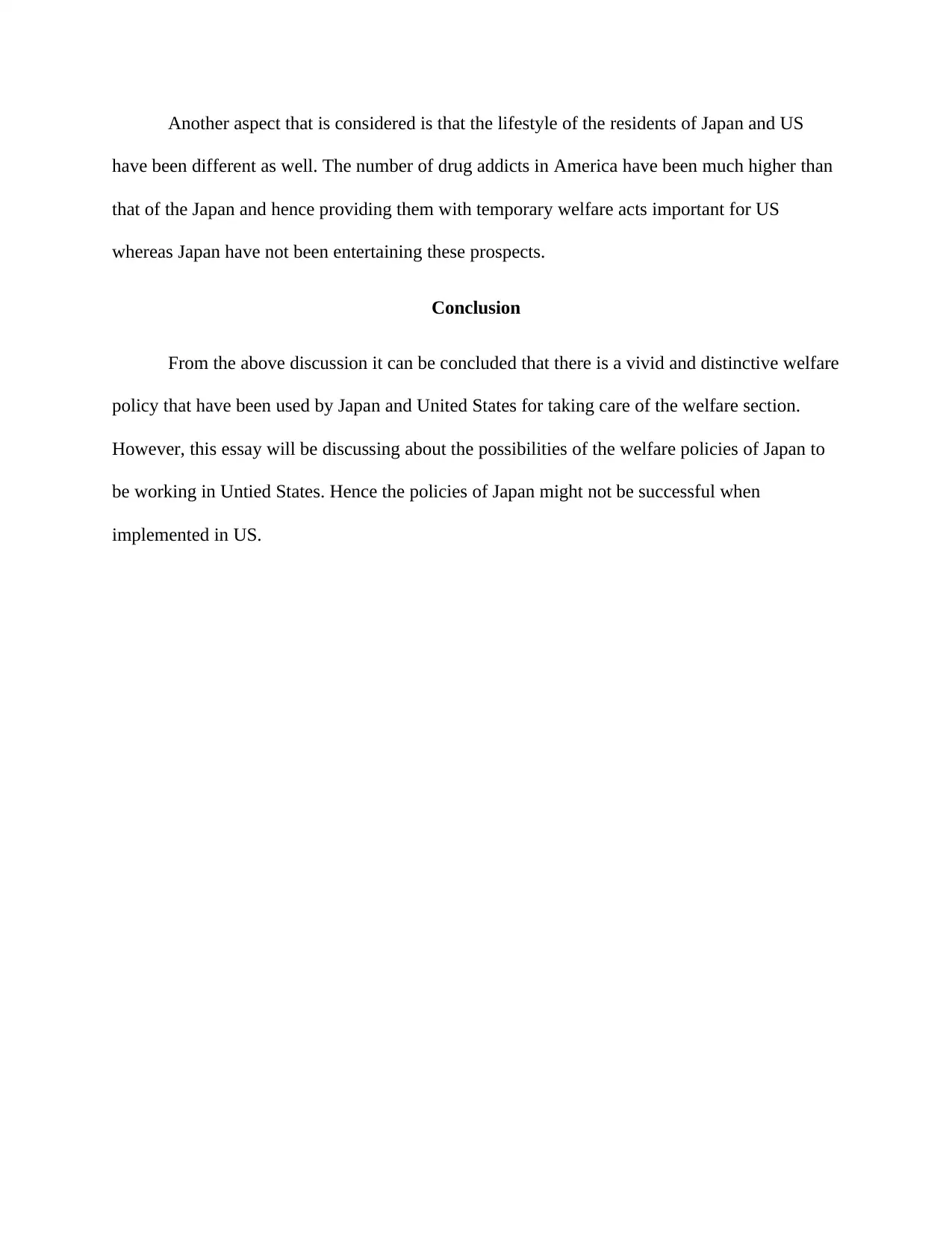
Another aspect that is considered is that the lifestyle of the residents of Japan and US
have been different as well. The number of drug addicts in America have been much higher than
that of the Japan and hence providing them with temporary welfare acts important for US
whereas Japan have not been entertaining these prospects.
Conclusion
From the above discussion it can be concluded that there is a vivid and distinctive welfare
policy that have been used by Japan and United States for taking care of the welfare section.
However, this essay will be discussing about the possibilities of the welfare policies of Japan to
be working in Untied States. Hence the policies of Japan might not be successful when
implemented in US.
have been different as well. The number of drug addicts in America have been much higher than
that of the Japan and hence providing them with temporary welfare acts important for US
whereas Japan have not been entertaining these prospects.
Conclusion
From the above discussion it can be concluded that there is a vivid and distinctive welfare
policy that have been used by Japan and United States for taking care of the welfare section.
However, this essay will be discussing about the possibilities of the welfare policies of Japan to
be working in Untied States. Hence the policies of Japan might not be successful when
implemented in US.
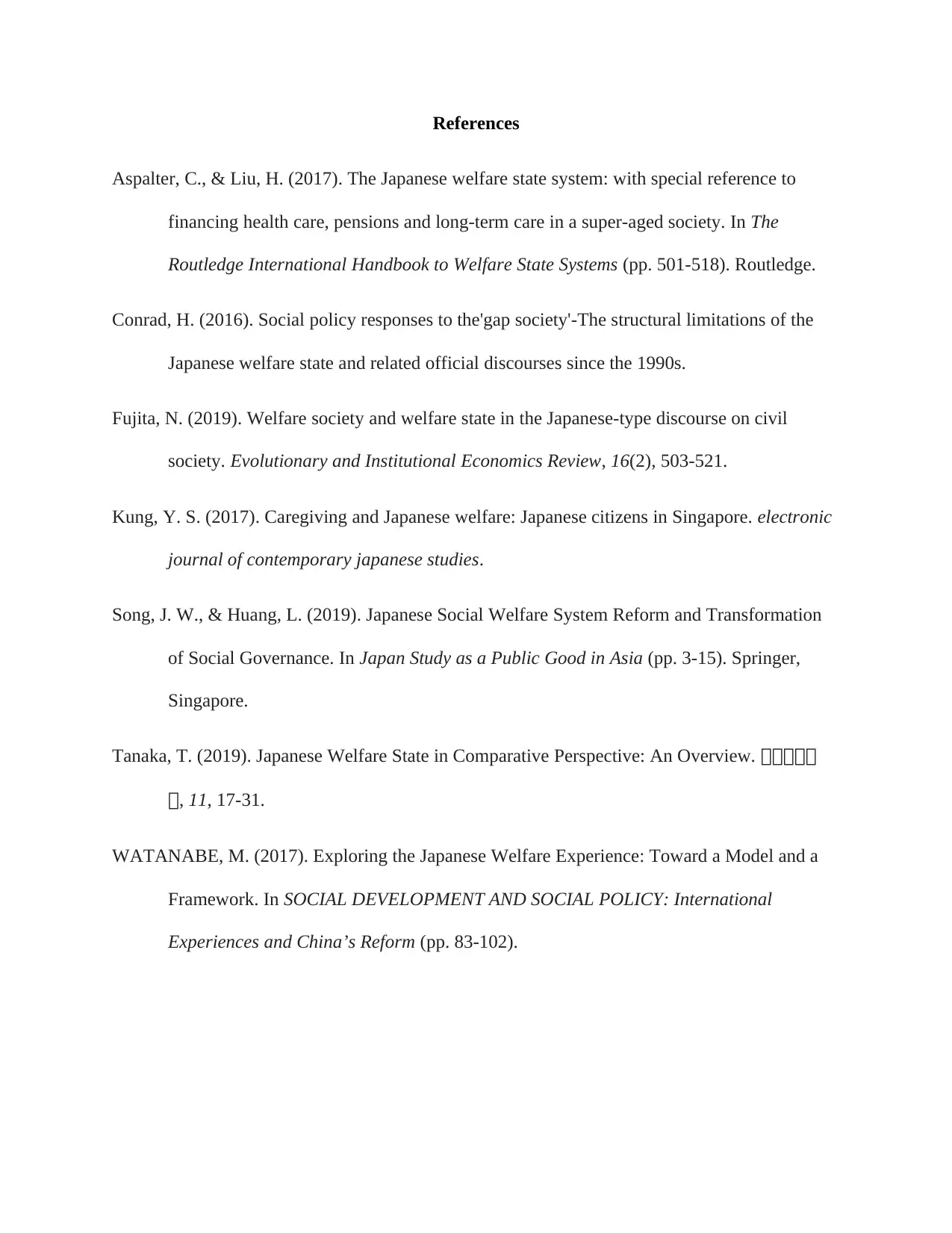
References
Aspalter, C., & Liu, H. (2017). The Japanese welfare state system: with special reference to
financing health care, pensions and long-term care in a super-aged society. In The
Routledge International Handbook to Welfare State Systems (pp. 501-518). Routledge.
Conrad, H. (2016). Social policy responses to the'gap society'-The structural limitations of the
Japanese welfare state and related official discourses since the 1990s.
Fujita, N. (2019). Welfare society and welfare state in the Japanese-type discourse on civil
society. Evolutionary and Institutional Economics Review, 16(2), 503-521.
Kung, Y. S. (2017). Caregiving and Japanese welfare: Japanese citizens in Singapore. electronic
journal of contemporary japanese studies.
Song, J. W., & Huang, L. (2019). Japanese Social Welfare System Reform and Transformation
of Social Governance. In Japan Study as a Public Good in Asia (pp. 3-15). Springer,
Singapore.
Tanaka, T. (2019). Japanese Welfare State in Comparative Perspective: An Overview. 一一一一一
一, 11, 17-31.
WATANABE, M. (2017). Exploring the Japanese Welfare Experience: Toward a Model and a
Framework. In SOCIAL DEVELOPMENT AND SOCIAL POLICY: International
Experiences and China’s Reform (pp. 83-102).
Aspalter, C., & Liu, H. (2017). The Japanese welfare state system: with special reference to
financing health care, pensions and long-term care in a super-aged society. In The
Routledge International Handbook to Welfare State Systems (pp. 501-518). Routledge.
Conrad, H. (2016). Social policy responses to the'gap society'-The structural limitations of the
Japanese welfare state and related official discourses since the 1990s.
Fujita, N. (2019). Welfare society and welfare state in the Japanese-type discourse on civil
society. Evolutionary and Institutional Economics Review, 16(2), 503-521.
Kung, Y. S. (2017). Caregiving and Japanese welfare: Japanese citizens in Singapore. electronic
journal of contemporary japanese studies.
Song, J. W., & Huang, L. (2019). Japanese Social Welfare System Reform and Transformation
of Social Governance. In Japan Study as a Public Good in Asia (pp. 3-15). Springer,
Singapore.
Tanaka, T. (2019). Japanese Welfare State in Comparative Perspective: An Overview. 一一一一一
一, 11, 17-31.
WATANABE, M. (2017). Exploring the Japanese Welfare Experience: Toward a Model and a
Framework. In SOCIAL DEVELOPMENT AND SOCIAL POLICY: International
Experiences and China’s Reform (pp. 83-102).
⊘ This is a preview!⊘
Do you want full access?
Subscribe today to unlock all pages.

Trusted by 1+ million students worldwide
1 out of 6
Related Documents
Your All-in-One AI-Powered Toolkit for Academic Success.
+13062052269
info@desklib.com
Available 24*7 on WhatsApp / Email
![[object Object]](/_next/static/media/star-bottom.7253800d.svg)
Unlock your academic potential
Copyright © 2020–2025 A2Z Services. All Rights Reserved. Developed and managed by ZUCOL.




